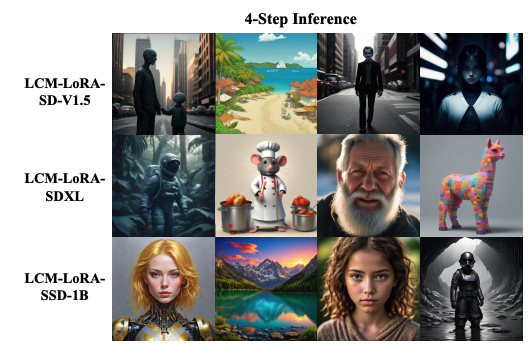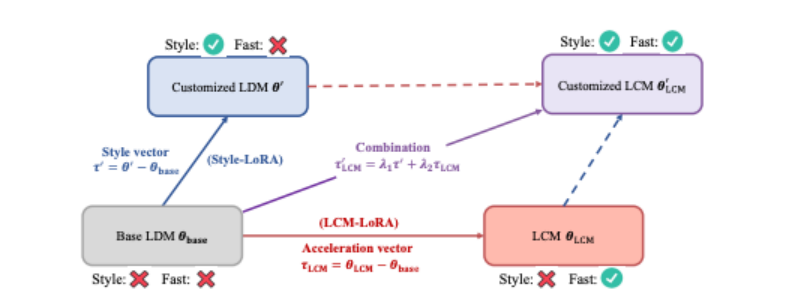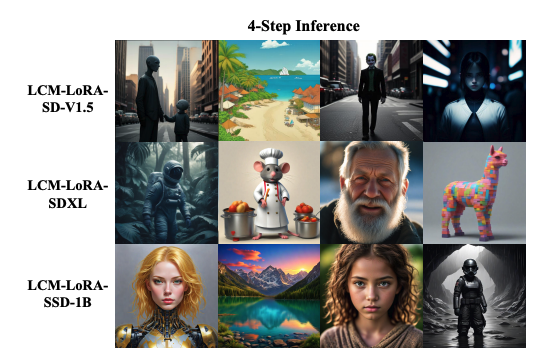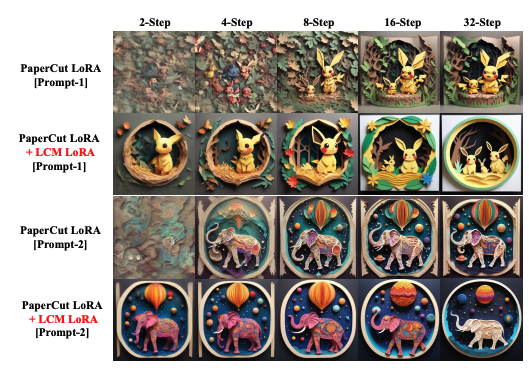LCM: New way to generate high-quality images dramatically faster
Author丨Mike Young
Translation: The language to re-create the content without changing the original meaning is Chinese, without the original sentence appearing
Review the content without changing the original meaning, the language needs to be rewritten In Chinese, the original sentence does not need to appear
Recommended | 51CTO Technology Stack (WeChat ID: blog51cto)
 ##Picture
##Picture
 By introducing LoRA into the refining process of LCM , we significantly reduce the memory overhead of refining, which allows us to train larger models, such as SDXL and SSD-1B, with limited resources. More importantly, the LoRA parameters ("acceleration vectors") obtained by LCM-LoRA training can be directly combined with other LoRA parameters ("style vectors") obtained by fine-tuning on a dataset for a specific style. Without any training, the model obtained by the linear combination of the acceleration vector and the style vector gains the ability to generate images of a specific painting style with a minimum of sampling steps.
By introducing LoRA into the refining process of LCM , we significantly reduce the memory overhead of refining, which allows us to train larger models, such as SDXL and SSD-1B, with limited resources. More importantly, the LoRA parameters ("acceleration vectors") obtained by LCM-LoRA training can be directly combined with other LoRA parameters ("style vectors") obtained by fine-tuning on a dataset for a specific style. Without any training, the model obtained by the linear combination of the acceleration vector and the style vector gains the ability to generate images of a specific painting style with a minimum of sampling steps.
Figure 2. The paper claims: “Using latent consistency models extracted from different pre-trained diffusion models Generated images. We used LCM-LoRA-SD-V1.5 to generate 512×512 resolution images, and LCM-LoRA-SDXL and LCM-LoRA-SSD-1B to generate 1024×1024 resolution images.”
3. Limitations
The current version of LCM has several limitations. The most important thing is the two-stage training process: first train the LDM, and then use it to train the LCM. In future research, a more direct method of LDM training may be explored, whereby LDM may not be required. The paper mainly discusses unconditional image generation, conditional generation tasks (such as text-to-image synthesis) may require more work.
4. Main Enlightenment
Latent Consistency Model (LCM) has taken an important step in quickly generating high-quality images. These models can produce results comparable to slower LDMs in just 1 to 4 steps, potentially revolutionizing the practical application of text-to-image models. Although there are currently some limitations, particularly in terms of the training process and the scope of the generation task, LCM marks a significant advance in practical image generation based on neural networks. The examples provided highlight the potential of these models
5, LCM-LoRA as a general acceleration module
As mentioned in the introduction, the paper is divided into two parts . The second part discusses LCM-LoRA technology, which enables fine-tuning of pre-trained models using less memory, thereby improving efficiency
The key innovation here is the integration of LoRA parameters into LCM , thereby generating a hybrid model that combines the advantages of both. This integration is particularly useful for creating images of a specific style or responding to a specific task. If different sets of LoRA parameters are selected and combined, each fine-tuned for a unique style, the researchers create a versatile model that can generate images with a minimum of steps and no additional training.
They demonstrated this in their research through the example of combining LoRA parameters fine-tuned for specific painting styles with LCM-LoRA parameters. This combination allows the creation of 1024 × 1024 resolution images with different styles at different sampling steps (such as 2-step, 4-step, 8-step, 16-step and 32-step). The results show that these combined parameters can produce high-quality images without further training, highlighting the efficiency and versatility of the model.
One thing worth noting here is the use of the so-called " The acceleration vector" (τLCM) and the "style vector" (τ) are combined using specific mathematical formulas (λ1 and λ2 are adjustable factors in these formulas). This combination results in a model that can quickly generate custom-styled images.
Figure 3 in the paper (shown below) demonstrates the effectiveness of this approach by showing the results of combining specific style LoRA parameters with LCM-LoRA parameters. This demonstrates the model's ability to generate images with different styles quickly and efficiently.
 Figure 3
Figure 3
In general, this article This section highlights the versatility and efficiency of the LCM-LoRA model, which can be used to quickly generate high-quality, style-specific images while using very few computational resources. The technology has a wide range of applications and is expected to revolutionize the way images are generated in everything from digital art to automated content creation
6. Conclusion
We studied a A new method, latent consistency model (LCM), is used to speed up the process of generating images from text. Unlike traditional latent diffusion models (LDM), LCM can generate images of similar quality in just 1 to 4 steps instead of hundreds of steps. This significant efficiency improvement is achieved through the refinement method, that is, using pre-trained LDM to train LCM, thus avoiding a large amount of computation
In addition, we also studied LCM-LoRA , an augmentation technique that uses low-rank adaptation (LoRA) to fine-tune pre-trained models to reduce memory requirements. This ensemble method can create specific styles of images with minimal computational steps without requiring additional training
Highlighted key results include LCM in just a few steps Creating high-quality 512x512 and 1024x1024 images requires hundreds of steps with LDM. However, the current limitation is that LDM relies on a two-step training process, so you still need LDM to get started! Future research may simplify this process.
LCM is a very clever innovation especially when combined with LoRA in the proposed LCM-LoRA model. They offer the advantage of creating high-quality images more quickly and efficiently, and I think they have broad application prospects in digital content creation.
Reference link: https://notes.aimodels.fyi/lcm-lora-a-new-method-for-generating-high-quality-images-much-faster/
The above is the detailed content of LCM: New way to generate high-quality images dramatically faster. For more information, please follow other related articles on the PHP Chinese website!

Hot AI Tools

Undresser.AI Undress
AI-powered app for creating realistic nude photos

AI Clothes Remover
Online AI tool for removing clothes from photos.

Undress AI Tool
Undress images for free

Clothoff.io
AI clothes remover

AI Hentai Generator
Generate AI Hentai for free.

Hot Article

Hot Tools

Notepad++7.3.1
Easy-to-use and free code editor

SublimeText3 Chinese version
Chinese version, very easy to use

Zend Studio 13.0.1
Powerful PHP integrated development environment

Dreamweaver CS6
Visual web development tools

SublimeText3 Mac version
God-level code editing software (SublimeText3)

Hot Topics
 1381
1381
 52
52
 How to clear desktop background recent image history in Windows 11
Apr 14, 2023 pm 01:37 PM
How to clear desktop background recent image history in Windows 11
Apr 14, 2023 pm 01:37 PM
<p>Windows 11 improves personalization in the system, allowing users to view a recent history of previously made desktop background changes. When you enter the personalization section in the Windows System Settings application, you can see various options, changing the background wallpaper is one of them. But now you can see the latest history of background wallpapers set on your system. If you don't like seeing this and want to clear or delete this recent history, continue reading this article, which will help you learn more about how to do it using Registry Editor. </p><h2>How to use registry editing
 How to Download Windows Spotlight Wallpaper Image on PC
Aug 23, 2023 pm 02:06 PM
How to Download Windows Spotlight Wallpaper Image on PC
Aug 23, 2023 pm 02:06 PM
Windows are never one to neglect aesthetics. From the bucolic green fields of XP to the blue swirling design of Windows 11, default desktop wallpapers have been a source of user delight for years. With Windows Spotlight, you now have direct access to beautiful, awe-inspiring images for your lock screen and desktop wallpaper every day. Unfortunately, these images don't hang out. If you have fallen in love with one of the Windows spotlight images, then you will want to know how to download them so that you can keep them as your background for a while. Here's everything you need to know. What is WindowsSpotlight? Window Spotlight is an automatic wallpaper updater available from Personalization > in the Settings app
 How to use image semantic segmentation technology in Python?
Jun 06, 2023 am 08:03 AM
How to use image semantic segmentation technology in Python?
Jun 06, 2023 am 08:03 AM
With the continuous development of artificial intelligence technology, image semantic segmentation technology has become a popular research direction in the field of image analysis. In image semantic segmentation, we segment different areas in an image and classify each area to achieve a comprehensive understanding of the image. Python is a well-known programming language. Its powerful data analysis and data visualization capabilities make it the first choice in the field of artificial intelligence technology research. This article will introduce how to use image semantic segmentation technology in Python. 1. Prerequisite knowledge is deepening
 iOS 17: How to use one-click cropping in photos
Sep 20, 2023 pm 08:45 PM
iOS 17: How to use one-click cropping in photos
Sep 20, 2023 pm 08:45 PM
With the iOS 17 Photos app, Apple makes it easier to crop photos to your specifications. Read on to learn how. Previously in iOS 16, cropping an image in the Photos app involved several steps: Tap the editing interface, select the crop tool, and then adjust the crop using a pinch-to-zoom gesture or dragging the corners of the crop tool. In iOS 17, Apple has thankfully simplified this process so that when you zoom in on any selected photo in your Photos library, a new Crop button automatically appears in the upper right corner of the screen. Clicking on it will bring up the full cropping interface with the zoom level of your choice, so you can crop to the part of the image you like, rotate the image, invert the image, or apply screen ratio, or use markers
 Use 2D images to create a 3D human body. You can wear any clothes and change your movements.
Apr 11, 2023 pm 02:31 PM
Use 2D images to create a 3D human body. You can wear any clothes and change your movements.
Apr 11, 2023 pm 02:31 PM
Thanks to the differentiable rendering provided by NeRF, recent 3D generative models have achieved stunning results on stationary objects. However, in a more complex and deformable category such as the human body, 3D generation still poses great challenges. This paper proposes an efficient combined NeRF representation of the human body, enabling high-resolution (512x256) 3D human body generation without the use of super-resolution models. EVA3D has significantly surpassed existing solutions on four large-scale human body data sets, and the code has been open source. Paper name: EVA3D: Compositional 3D Human Generation from 2D image Collections Paper address: http
 New perspective on image generation: discussing NeRF-based generalization methods
Apr 09, 2023 pm 05:31 PM
New perspective on image generation: discussing NeRF-based generalization methods
Apr 09, 2023 pm 05:31 PM
New perspective image generation (NVS) is an application field of computer vision. In the 1998 SuperBowl game, CMU's RI demonstrated NVS given multi-camera stereo vision (MVS). At that time, this technology was transferred to a sports TV station in the United States. , but it was not commercialized in the end; the British BBC Broadcasting Company invested in research and development for this, but it was not truly commercialized. In the field of image-based rendering (IBR), there is a branch of NVS applications, namely depth image-based rendering (DBIR). In addition, 3D TV, which was very popular in 2010, also needed to obtain binocular stereoscopic effects from monocular video, but due to the immaturity of the technology, it did not become popular in the end. At that time, methods based on machine learning had begun to be studied, such as
 How to batch resize images using PowerToys on Windows
Aug 23, 2023 pm 07:49 PM
How to batch resize images using PowerToys on Windows
Aug 23, 2023 pm 07:49 PM
Those who have to work with image files on a daily basis often have to resize them to fit the needs of their projects and jobs. However, if you have too many images to process, resizing them individually can consume a lot of time and effort. In this case, a tool like PowerToys can come in handy to, among other things, batch resize image files using its image resizer utility. Here's how to set up your Image Resizer settings and start batch resizing images with PowerToys. How to Batch Resize Images with PowerToys PowerToys is an all-in-one program with a variety of utilities and features to help you speed up your daily tasks. One of its utilities is images
 Erase blemishes and wrinkles with one click: in-depth interpretation of DAMO Academy's high-definition portrait skin beauty model ABPN
Apr 12, 2023 pm 12:25 PM
Erase blemishes and wrinkles with one click: in-depth interpretation of DAMO Academy's high-definition portrait skin beauty model ABPN
Apr 12, 2023 pm 12:25 PM
With the vigorous development of the digital culture industry, artificial intelligence technology has begun to be widely used in the field of image editing and beautification. Among them, portrait skin beautification is undoubtedly one of the most widely used and most demanded technologies. Traditional beauty algorithms use filter-based image editing technology to achieve automated skin resurfacing and blemish removal effects, and have been widely used in social networking, live broadcasts and other scenarios. However, in the professional photography industry with high thresholds, due to the high requirements for image resolution and quality standards, manual retouchers are still the main productive force in portrait beauty retouching, completing tasks including skin smoothing, blemish removal, whitening, etc. Series work. Usually, the average processing time for a professional retoucher to perform skin beautification operations on a high-definition portrait is 1-2 minutes. In fields such as advertising, film and television, which require higher precision, this




